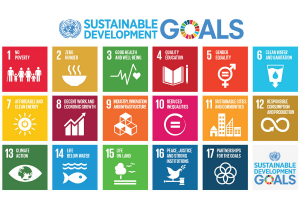FastCompany today featured a superb article by one of their NY staff writers, Ben Schiller, looking at a report entitled The Global Opportunity Report by the United Nations, DNV GL and Sustainia (Scandinavian think tanks). This is all spot on the money: I have nothing to add – just read it at the FastCompany website, or an extract below:
4 Of Our Biggest Global Problems Are Big Business Opportunities
As the world falls behind on some of the Sustainable Development Goals–inequality, consumption, climate change, and clean oceans–there are also places for aspiring social entrepreneurs to find a niche.
When the United Nations set out its Sustainable Development Goals in 2015, it was detailing not only an agenda for government and aid groups, but also one for business. Covering everything from global hunger to gender equality, the SDGs are a rich diet of opportunity. They show ways for companies to make money and to become engines of progress in the world.
A new report reframes the 17 SDGs along these lines, helping companies that say they want to enact an SDG agenda…. The report focuses on four SDGs that need most attention and some of the boldest action: inequality, responsible consumption, climate change, and oceans management.
Key to the report is the idea that companies can do more than be responsible actors. They can actually create solutions that improve lives and develop new markets. In other words, being responsible isn’t some moral choice, but rather it’s smart strategic planning. “Responsible and sustainable business is no longer a small niche industry. Rather, these markets have the potential to be the key drivers of business growth in the coming decades,” the report says.
Below are a few business ideas in each category, with some example startups already operating and showing the way.
GOAL 10: REDUCING INEQUALITY
The global wealthiest 1% controls more than three-quarters of the world’s wealth, while half the world’s population owns just 1% of its wealth. Inequality is on the increase across the globe, not only in the United States, but notably in countries like South Africa, Brazil, the Middle East, India, China, and parts of Africa.
One big idea for improving the lives of the poor is to help them prove ownership of what they have. In many developing countries, registries of land titling are either sparse or open to abuse. Blockchain ledgers create inviolable, distributed records ownership and are currently being employed everywhere from the Republic of Georgia to Ghana, where a startup called BenBen has developed a blockchain-based property management system.
Land titling sounds boring, but better registries have numerous spillover effects, including opening up access to credit. “Blockchain technology has the potential to eliminate many barriers around trust and the transparency of assets that marginalize these groups,” says BenBen’s CEO Emmanuel Buetey Noah, in the report.
Another blockchain idea: improving transparency in supply chains. When farmers can prove their harvests are premium quality and come from a specific place–as is possible with these in-field coffee bean-counters–they can win higher prices and form more direct relationships with end-consumers.
GOAL 12: RESPONSIBLE CONSUMPTION AND PRODUCTION
Companies have traditionally thrived by getting consumers to buy more stuff. Linear models of consumption have ruled the world but had a horrific impact on the environment. The future opportunities are in circularity: closed-loop systems of consumption and recycling, and designing products so they can be broken down at end of life and reassembled in new combinations. Turning products into services is one promising concept for the circular economy.
The report lays out three areas of possible exploitation: alternative food sources (like businesses built around insect production that require less water and energy than traditional meat production); construction; and what it calls “reuse to repower.” Construction ideas: WinSun, a Chinese company that 3D-prints buildings from solid industrial waste; Kokoboard, a Thai startup that makes building materials from coconut husks, peanut shells, and rice straw; and Blue Planet, which converts industrial CO2 into a building aggregate.
As for re-powering, how about taking old car batteries that would normally be thrown away and creating backup power plants?
GOAL 13: CLIMATE ACTION
The gap between where the world needs to go on climate emissions and where it is currently moving remains enormous. Emissions need to peak in 2020 and start falling by 2030, and that’s not very likely at present (that the U.S. has re-embraced coal doesn’t help).
The report lays out some climate opportunities for business, including “upcycling” (taking CO2 and making it into something useful, like building materials), district cooling systems as an alternative to ruinous air-conditioning units, and more sustainable shipping–an transport mode that doesn’t get enough attention from climate hawks. Electrifying and automating ports and ships, using alternative fuels, and even sails can improve efficiency (and therefore carbon emissions) by 40% by midcentury, the report says.
GOAL 14: PRESERVE THE OCEANS
At current rates, there may be more plastic in the oceans than fish by 2050. But nothing is inevitable: There are plenty of promising ideas for reinventing plastics, from marine-degradable compounds to multifunctional plastics that are easier to recycle, that could mean less plastic going in the oceans.
The report also looks at alternative forms of aquaculture that reduce reliance on traditional (over)fishing. FarmInABox is a flat-packed modular fish farm from South Africa. FeedKind is a fish feed produced from naturally occurring soil microbes. GreenWave is vertical farming for high-end edible seaweed.
Sustainia, in fact, is a wealth of SDG-focused business ideas. See here for more at its Global Opportunity Explorer website.


